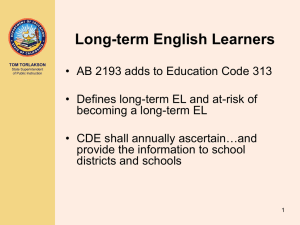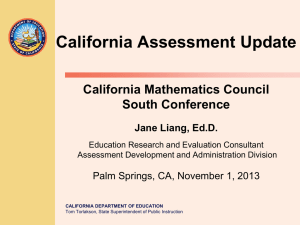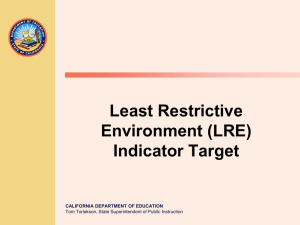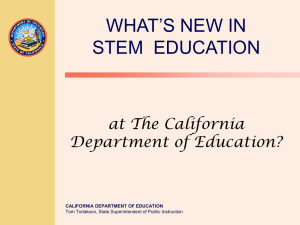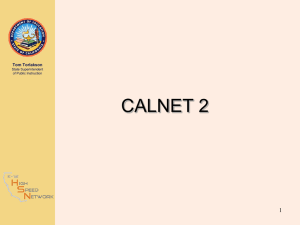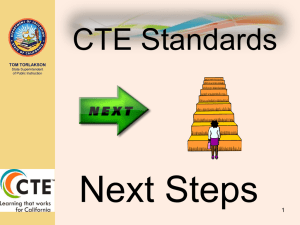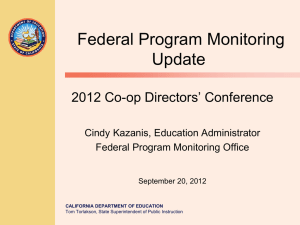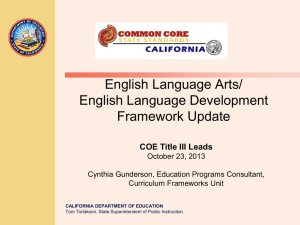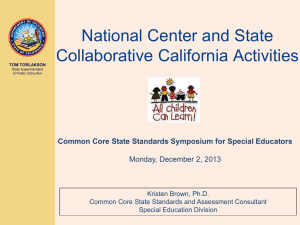Indirect Costs - California Association of School Business Officials
advertisement
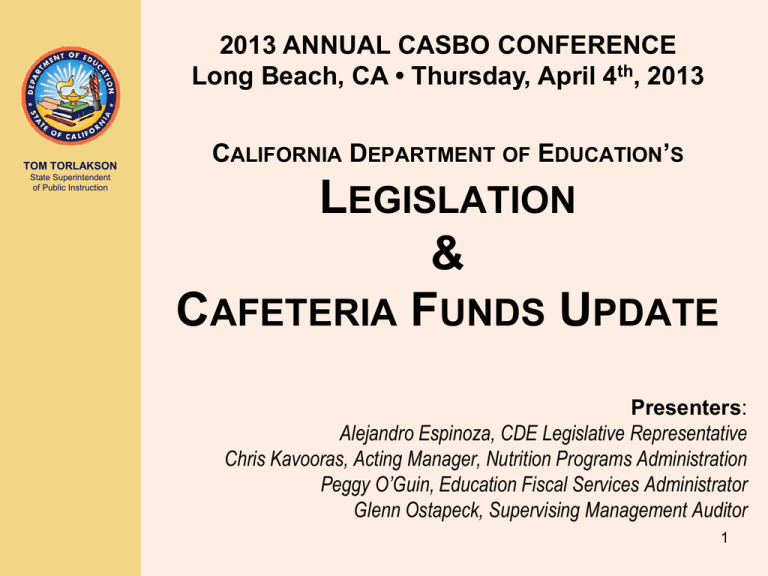
2013 ANNUAL CASBO CONFERENCE Long Beach, CA • Thursday, April 4th, 2013 TOM TORLAKSON State Superintendent of Public Instruction CALIFORNIA DEPARTMENT OF EDUCATION’S LEGISLATION & CAFETERIA FUNDS UPDATE Presenters: Alejandro Espinoza, CDE Legislative Representative Chris Kavooras, Acting Manager, Nutrition Programs Administration Peggy O’Guin, Education Fiscal Services Administrator Glenn Ostapeck, Supervising Management Auditor 1 Today’s Legislative Update: TOM TORLAKSON State Superintendent of Public Instruction • AB 626 (Skinner) – SSPI Sponsored Legislation • AB 402 (Skinner) Implementation • “Food Fight” Report 2 TOM TORLAKSON AB 626 (Skinner) and the California Healthy HungerFree Kids Act State Superintendent of Public Instruction • SSPI Sponsor • AB 626 aligns State law to comply with the new federal laws and regulations set forth by the Healthy, Hunger-Free Kids Act of 2010 3 AB 402 (Skinner) TOM TORLAKSON State Superintendent of Public Instruction • AB 402 utilizes information contained in the school meal program application to initiate the determination of eligibility for the CalFresh (formerly Food Stamps) program. 4 AB 402 (Skinner) TOM TORLAKSON State Superintendent of Public Instruction • Working with CDSS • Development of documents – Consent Form – MOU Template – CDE Management Bulletin 5 Food Fight Report TOM TORLAKSON State Superintendent of Public Instruction • What is it? • What are the issues? • What is CDE doing to address these issues? 6 Today’s Cafeteria Fund Presentation TOM TORLAKSON State Superintendent of Public Instruction • • • • • • SSPI’s Comments Governing Regulations & Guidance Cost Principles Indirect Costs 101 Recent Audit Findings Questions 7 State Superintendent of Public Instruction TOM TORLAKSON State Superintendent of Public Instruction “Over the past five years, the CDE has discovered and investigated an increasing number of cafeteria fund misappropriations. In response to this growing threat to school nutrition program operations, the CDE’s Nutrition Services Division developed cafeteria fund and financial management training for food service directors. . . . Both federal and California state law govern cafeterias (school food services) and their restricted accounts. These laws protect cafeteria funds and affirm that they may only be used for the maintenance and improvement of school food services. While California’s Legislature has tried to provide districts with flexibility in managing all of their funds during these tough economic times, it is important for you to note that federal laws prohibit the use or transfer of cafeteria funds for other purposes. . . .” Letter to County & District Superintendents • May 21, 2012 8 TOM TORLAKSON State Superintendent of Public Instruction To see how the State Superintendent has supported California’s schools during California’s financial crisis, visit his School Financial Emergency Web page at: http://www.cde.ca.gov/nr/re/ht/fe.asp 9 TOM TORLAKSON Chief Business Official (CBO) State Superintendent of Public Instruction Part of a CBO’s job is to stretch district and State funds by maximizing legitimate charges to federal funds. 10 TOM TORLAKSON State Superintendent of Public Instruction The regulations and policies governing Cafeteria Funds are numerous and complex 11 Governing Laws, Regulations, and Policies TOM TORLAKSON State Superintendent of Public Instruction Local Educational Agencies (LEAs) are required to comply with State and federal limitations LEAs must reference numerous sources to understand and determine allowable uses of Cafeteria Funds: • Federal Regulations, Policy, Instructions, Guidance • California Education Code (EC) • Office of Management and Budget Circulars • USDA Policy Memos • The California School Accounting Manual (CSAM) 12 Cafeteria Fund Management Bulletins (MB) TOM TORLAKSON State Superintendent of Public Instruction • 00-109: Use of Cafeteria Funds Update • NSD-SNP-05-2009: School Cafeteria Funds FAQs • NSD-SNP-07-2008: Limitations on Transfer of Funds • USDA-SNP-16-2009: School Nutrition Program Interest Earned on the Cafeteria Account/Fund • NSD-SNP-05-2012: Cafeteria Funds–Reminders and Resources • NSD-SNP-04-2013: Revenue Sharing in School Nutrition Programs See complete list of all MBs at: http://www.cde.ca.gov/ls/nu/sn/mb.asp 13 What is the Cafeteria Account? TOM TORLAKSON State Superintendent of Public Instruction A statutorily required and restricted account used by districts to track the revenue and expenses related to their non-profit school food service. 14 Defined in State Law TOM TORLAKSON State Superintendent of Public Instruction “All receipts of the cafeteria, or cafeterias [defined as school food services], as the case may be, derived from the sale of food shall be deposited in the account and shall be expended only for the maintenance of the cafeteria, or cafeterias…” [emphasis added] California Education Code (EC) Section 38093 15 Defined in Federal Law TOM TORLAKSON State Superintendent of Public Instruction “Nonprofit school food service account means the restricted account in which all of the revenue from all food service operations conducted by the school food authority principally for the benefit of school children is retained and used only for the operation or improvement of the nonprofit school food service.” [Emphasis added] Title 7, Code of Federal Regulations (7 CFR) Section 210.2 16 Revenue TOM TORLAKSON State Superintendent of Public Instruction “Revenue, when applied to nonprofit school food service, means all monies received by or accruing to the nonprofit school food service in accordance with the State agency's established accounting system including, but not limited to, children's payments, earnings on investments, other local revenues, State revenues, and Federal cash reimbursements… .” [Emphasis added] 7 CFR 210.2 17 Commingling of Funds TOM TORLAKSON State Superintendent of Public Instruction Once monies or revenues have been deposited into the cafeteria account, they are considered part of the non-profit food service, and are governed, protected, and restricted by federal and State laws. 7 CFR 210.2, 210.14, 210.19; EC sections 38080-38103 18 Restricted Account California Education Code (EC): TOM TORLAKSON State Superintendent of Public Instruction • Term “Cafeteria” synonymous with food service • Requires all revenues from sales of the cafeteria be deposited into the cafeteria account, and spent on maintenance of the cafeteria • Authorizes expenditures from the cafeteria fund or cafeteria account only for those charges that are defined in the CA School Accounting Manual (CSAM) or are reported to the CDE • Does not allow food services to be charged more than once for the same service EC sections 38080-38100, et seq. 19 Restricted Account Federal regulations: TOM TORLAKSON State Superintendent of Public Instruction • Requires fund to be non-profit • Requires all revenue from food service operations be retained and used only for the operation or improvement of the nonprofit school food service. • Expenditures of nonprofit school food service revenues shall be in accordance with the financial management system established by the State agency (CSAM) 7 CFR 210.2 and 210.14 20 General Cost Principles TOM TORLAKSON State Superintendent of Public Instruction Be Necessary and Reasonable for proper & efficient performance & administration of the federal award • Benefit the Program • Must follow sound business practices • Market price for comparable goods and services • Be prudent under the circumstances and not deviate from standard practice 2 CFR 225 21 General Cost Principles TOM TORLAKSON State Superintendent of Public Instruction Allocable • Can only charge in proportion to the relative benefit received by the Program • Example: A food transport vehicle purchased solely for the use of the School Nutrition Program Legal under state and local law • If cannot do under state law, cannot pay with federal funds Conforming with federal law and grant terms • Example: Match requirements/special conditions 2 CFR 225 22 General Cost Principles TOM TORLAKSON State Superintendent of Public Instruction Consistently treated • Must follow uniform policies that apply equally to federal and non-federal activities • Cannot assign cost as direct cost if indirect under state programs Net of applicable credits • Example: rebates, discounts, credits – anything that reduces the price 2 CFR 225 23 General Cost Principles TOM TORLAKSON State Superintendent of Public Instruction Adequately documented • How funds are expended − Invoices − Receipts • Other records to facilitate an effective audit − Purchase orders − Proof of delivery or performance − Approvals 2 CFR 225 24 General Cost Principles TOM TORLAKSON State Superintendent of Public Instruction California Education Code (EC): • Requires a written explanation of the purpose of and basis for any charges to, or transfers from, a food service program. • Does not authorize a school district to charge a food service program any charges prohibited by state or federal law or regulation. EC 38101 (d)(e) 25 Allocation of Costs TOM TORLAKSON State Superintendent of Public Instruction There are two types of costs: 1. Direct 2. Indirect 26 Allocation of Costs TOM TORLAKSON State Superintendent of Public Instruction Said another way, there are two ways to charge costs to programs: 1. Directly 2. Indirectly Subject to certain rules: Some costs can only be direct, some can only be indirect, & some could be either (but cannot be both) 27 Direct Costs TOM TORLAKSON State Superintendent of Public Instruction Specifically for Performance of the Program • Salaries – for cooks, managers, food service director • • • • Food - for school meal programs Food Service Equipment and Supplies Food Transport Vehicles Travel – if necessary 28 Indirect Costs TOM TORLAKSON State Superintendent of Public Instruction Agency-wide, General Management Costs: • Incurred for common or joint purpose • Benefit more than one cost objective • Not readily assignable to individual cost objectives without effort disproportionate to the benefit CDE Web Indirect Cost Web Page: http://www.cde.ca.gov/fg/ac/ic/ CSAM Procedure 915, Indirect Cost Rate: http://www.cde.ca.gov/fg/ac/sa/index.asp USDA Indirect Cost Manual, 2011: http://www.fns.usda.gov/cnd/Governance/ Policy-Memos/2011/SP41-2011_os.pdf 29 Indirect Costs TOM TORLAKSON State Superintendent of Public Instruction In simplified terms, the “indirect cost rate” is the ratio of administrative overhead costs to the other operating costs • General administrative costs are the numerator • Other operating costs are the denominator • The resulting ratio is the “indirect cost rate” 30 Indirect Cost Calculation TOM TORLAKSON • Indirect Cost Rate expressed in words: State Superintendent of Public Instruction 31 Indirect Cost Calculation TOM TORLAKSON State Superintendent of Public Instruction • Indirect Cost Rate expressed in math: 32 Indirect Cost Calculation TOM TORLAKSON State Superintendent of Public Instruction • Of course the realities are more complex • CSAM Procedure 915 contains all the details (in your handout) 33 Indirect Cost Rules TOM TORLAKSON State Superintendent of Public Instruction • The U.S. Department of Education (USDE) delegates authority to CDE to approve indirect cost rates for LEAs • CDE carries out this responsibility in accordance with the terms of a formally negotiated indirect cost plan • CDE and USDE renegotiate the plan periodically 34 Indirect Cost Rules • USDE is the cognizant agency for LEA indirect cost rules TOM TORLAKSON State Superintendent of Public Instruction • The terms of the indirect cost plan that CDE negotiates with USDE are binding on other agencies 2 CFR, Part 225, Attachment A • Case in point: USDA’s June 2011 guidance mentions excluding food, but CDE’s ICR plan currently doesn’t (also see handout) • BTW – see illustration of effect of excluding food, in handout 35 Indirect Costs Federal Oversight TOM TORLAKSON State Superintendent of Public Instruction Reauthorization of Child Nutrition Programs USDA recently issued guidance on program rules for applying indirect costs and will study the extent of indirect costs used in food service. Recent or current activities: • Guidance Issued July 2011 (MB USDA-SNP-22-2011) • Indirect Cost Study in 2012 • Report to Congress by October 1, 2013 36 Indirect Costs State Oversight TOM TORLAKSON State Superintendent of Public Instruction School districts cannot recoup prior year indirect costs that were paid from a non school food service account. Exception: Unless a formal written contemporaneous agreement exists to show that the district had been “loaning” the nonprofit school food service account funds to cover the indirect costs in one or more prior years. 37 Indirect Costs State Oversight TOM TORLAKSON State Superintendent of Public Instruction Ed Code requires that an "indirect cost" be limited to the lesser of: 1) the school district's CDE-approved indirect cost rate or 2) the Statewide average school nutrition indirect cost rate EC 38101(c) 38 Recent Audit Findings TOM TORLAKSON State Superintendent of Public Instruction Recent nutrition audits have resulted in audit findings related to: • Employee salaries and benefits • Utilities & maintenance • Interest • Interfund Transfers 39 Salaries and Benefits TOM TORLAKSON State Superintendent of Public Instruction Employee salaries and benefits are allowable as a direct charge to the cafeteria fund if the proper supporting documentation is maintained in accordance with federal requirements 2 CFR, Part 225, Appendix B.8 40 Salaries and Benefits (single cost objective) TOM TORLAKSON State Superintendent of Public Instruction Employees who work on a single objective must maintain certifications that: • Certify the employee works solely on that program/cost objective • Are prepared at least semi-annually • Are signed by the employee or supervisor 2 CFR, Part 225, Appendix B.8.h.3 41 TOM TORLAKSON State Superintendent of Public Instruction 42 Salaries and Benefits (multiple cost objective) TOM TORLAKSON State Superintendent of Public Instruction Employees who work on multiple cost objectives must maintain personnel activity reports that: • Reflect an after-the-fact distribution of the actual activity of each employee • Account for the total activity each employee is compensated • Are prepared at least monthly and coincide with one or more pay periods • Are signed by the employee 2 CFR, Part 225, Appendix B.8.h.4 43 Salaries and Benefits (multiple cost objectives) TOM TORLAKSON State Superintendent of Public Instruction Examples of employees that may be required to maintain PARs: • Activity Supervisors • Custodians • Security • Warehouse • Maintenance • Groundskeepers • Administrative food service staff that work less than 100% on food service activities 44 Sample Personnel Activity Report (PAR) TOM TORLAKSON State Superintendent of Public Instruction 45 Utilities and Maintenance TOM TORLAKSON State Superintendent of Public Instruction Utilities and maintenance costs such as electricity, gas, water, and repairs may be directly charged to the nutrition programs if there is mechanism to quantify exactly the benefit to food services operations 46 Utilities and Maintenance (Utilities) TOM TORLAKSON State Superintendent of Public Instruction In order to directly charge utilities to the nutrition programs: • Kitchen/serving area only • Separate meters for food service operations • Utility provider invoice or statement 47 Utilities and Maintenance (Maintenance) TOM TORLAKSON State Superintendent of Public Instruction In order to directly charge maintenance and repairs to the nutrition programs: • Kitchen/serving area equipment only • Job cost ticket or similar documentation detailing labor costs incurred based on actual labor hours expended • Vendor invoice or statement (if repaired by external vendor) USDA, FNS, Indirect Cost Guidance, Appendix 4 48 Interest Earnings & Expense • Interest income/earnings is allowed TOM TORLAKSON State Superintendent of Public Instruction • Interest Expense is not allowed on borrowed capital • Interest Expense is not allowed for the use of the district’s own funds Title 2, CFR, Part 225, Appendix B.23 49 Interfund Transfers TOM TORLAKSON State Superintendent of Public Instruction Charges to, or transfers from, the cafeteria fund must: • Indicate when the original charge or transfer was made • Include a written explanation of the purpose of, and basis for, the expenditure • Cannot exceed the actual cost incurred Note: Does not authorize a school district to charge a food service program any charges prohibited by state or federal regulations. EC sections 38101 & 38103 50 TOM TORLAKSON State Superintendent of Public Instruction There is a right way and a wrong way to charge expenses to the cafeteria fund. 51 Cafeteria Fund Charges The Right way: TOM TORLAKSON State Superintendent of Public Instruction • Charge time documented by Personnel Activity Reports (“PARS”) or equivalent documentation for employees working in/for the nonprofit school food service operation to the cafeteria fund • Charge only actual supplies and expenses used in school food services to the cafeteria fund • Charge costs consistently to all programs including the cafeteria fund 2 CFR, Part 225 52 Cafeteria Fund Charges TOM TORLAKSON State Superintendent of Public Instruction The WRONG way: • Project time or use time studies for employees working in/for the nonprofit school food service operation • Project or use percentages of supplies, equipment, and electricity used in school food services • Charge other program(s) services or staffing to the cafeteria fund using erroneous allocation methods 53 Consequences for Improper Charges TOM TORLAKSON State Superintendent of Public Instruction If the CDE determines that a district charged unallowable expenses to the cafeteria fund, the CDE will direct the district to transfer the amount improperly expended (via payment plan or in whole) back into the cafeteria fund -- to be used solely for the maintenance and improvement of the district’s food service program. EC 38101(f) 54 What does CDE look for? TOM TORLAKSON State Superintendent of Public Instruction During “Administrative Reviews” and the analysis of Summer/Saturday meal waivers, the CDE looks at an LEA’s “Net Cash Resources (NCR).” 55 Net Cash Resources (NCR) TOM TORLAKSON State Superintendent of Public Instruction “… all monies, as determined in accordance with the State agency’s established accounting system [CSAM], that are available to or have accrued to a school food authority’s nonprofit school food service at any given time, less cash payable. Such monies may include, but are not limited to, cash on hand, cash receivable, earnings on investments, cash on deposit and the value of stocks, bonds or other negotiable securities.” 7 CFR 210.2 - Definitions 56 Net Cash Resources (NCR) (continued) TOM TORLAKSON State Superintendent of Public Instruction “The school food authority shall limit its net cash resources to an amount that does not exceed 3 months average expenditures for its nonprofit school food service or such other amount as may be approved by the State agency in accordance with Section 210.19(a).” 7 CFR 210.14 - Definitions 57 Net Cash Resources (NCR) TOM TORLAKSON State Superintendent of Public Instruction There are two sets of rules: 1. Allowable costs when NCR is less than three months average operating costs 2. Allowable costs when NCR is in excess of three months average operating costs 58 #1 NCR Rule TOM TORLAKSON State Superintendent of Public Instruction Per federal guidance, the LEA must follow all State/federal regulations and policies, and not jeopardize the integrity of the nonprofit school food service by reducing its NCR below 3 months operating costs. 59 #2 NCR Rule TOM TORLAKSON State Superintendent of Public Instruction When an LEA’s NCR is in excess of three months average expenditures, the NSD must approve how a LEA plans to expend the excess. At this time, please look at your Spending Plan handout 7 CFR 210.19(a)(2) 60 Conclusion TOM TORLAKSON State Superintendent of Public Instruction The CDE is committed to assisting LEAs so they can avoid mischarging expenses to the cafeteria fund, and having to pay back the money later, plus interest, and/or penalties. 61 On the Horizon TOM TORLAKSON State Superintendent of Public Instruction 2013 and beyond: Financial Management training for School Food Service – check the CDE Web site for information and check your e-mail for messages from NSD for details! 2013-14: Development of additional MBs, Web pages, and specialized training regarding the Use of Cafeteria Funds Also on the Horizon … More training from NSD at conferences, CSNA Chapter Meetings, and other venues; updated online resources 62 Questions? TOM TORLAKSON State Superintendent of Public Instruction 63 For questions not addressed today, please contact: TOM TORLAKSON State Superintendent of Public Instruction California Department of Education Nutrition Services Division School Nutrition Programs Unit 800-952-5609 Field Services Unit 916-323-4558 California School Accounting Manual http://www.cde.ca.gov/fg/ac/sa/ 64 Thank you for joining us today. TOM TORLAKSON State Superintendent of Public Instruction 65
